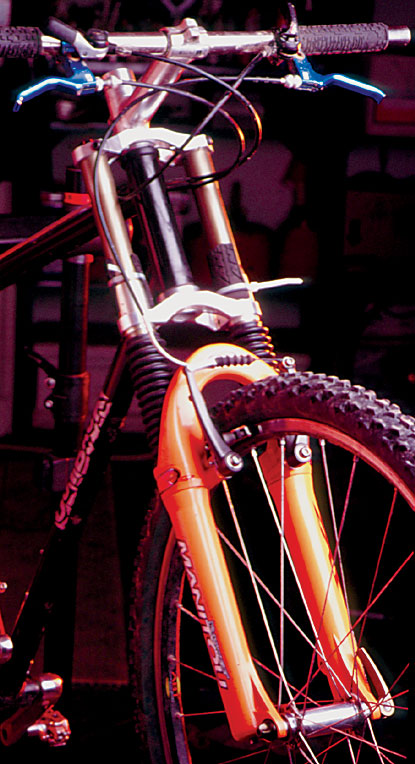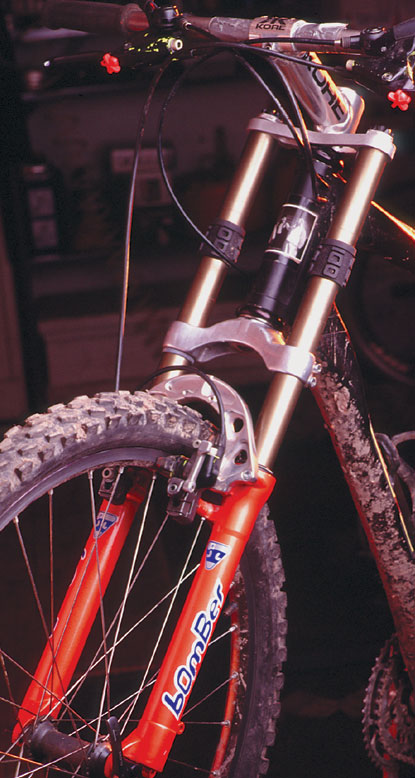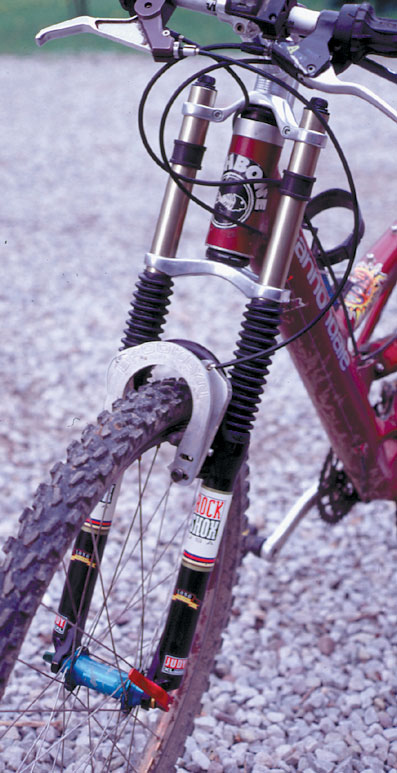Blast From the Past: Five Freeride Fork Reviews From 1998
Originally posted on July 23, 2015 at 15:30 pmEditor’s note: This “shootout” style product review first appeared in Dirt Rag Issue #66, published in July 1998—back when 100 mm of travel was considered “freeride” territory. This look back offers perspective on how far mountain biking, and suspension technology, has evolved since then.
These five so-called double-triple clamp forks are good for something besides paperweights. They offer stiffness, safety and travel. Here’s some stats and some thoughts. Figure it out.

- Manitou X-Vert R
- Price: $539
- Travel: 100 mm
- Weight: 4.75 pounds
- Stanchion diameter: 30 mm (with 35 mm bulges)
- Spring: one coil/MCU in right leg
- Damping: Speed sensitive damping controlled by shim stacks. Most technically advanced damper with independent rebound and compression controls. Large volume of oil for more control of adjustment, fewer heat-related problems. In left leg.
- Adjustability: Spring weight, preload, compression damping, rebound damping, oil weight.
- Rigidity (on a scale of 1 to 10): 7.5
- Kooshiness: Very responsive on small stuff. Most progressively stiffer through travel.
- Sizing: Three different size forks available for different head tube sizes. Make sure to measure your head tube before buying.
- Highlights: TPC technology. Externally butted stanchions. Plenty of adjustability. A nice tuning manual is available to help you dial the fork in well. Technology to price ratio very high.
- Lowlights: Preload knobs very difficult to turn.

- Cannondale Moto FR
- Price: $699
- Travel: 100 mm
- Weight: 5.75 pounds
- Stanchion diameter: 32 mm (square)
- Spring: one coil with internal MCU in right leg
- Damping: Five-position damper in left leg. Big difference between the different positions. Top position is really, really slow—this came in handy on uphills because it decreased bobbing well.
- Adjustability: Spring weight, damping, preload adjustment via extra-long 5-mm wrench. If you want to get technical, you can adjust the oil weight and shim stack for separate rebound and compression changes. Choice of three coil springs.
- Rigidity (on a scale of 1 to 10): 9.5 The stiffest of all five forks. Besides having very large tubing diameter, the square inner tube with four sets of 22 bearings per leg also stops twisting completely.
- Kooshiness: Hard to explain. It is but it isn’t. Sounds dirty, but works smoothly when operating, this due to the bearings being under load.
- Sizing: One size fits all. This fork fit every bike in the shop, no problem.
- Highlights: Super stiff. Super trick.
- Lowlights: Weight. Long Allen key needed for preload adjustment. Expensive.

- Marzocchi Bomber Jr. T
- Price: $595
- Travel: 110 mm
- Weight: 5.38 pounds
- Stanchion diameter: 30 mm
- Spring: steel springs in both legs
- Damping: Dual stage. Damping increases 30 percent into the stroke part of travel. Non adjustable. Supposed to be suitable for most conditions out of the box. Hard to bottom out due to dual-stage damping.
- Adjustability: Spring weight, preload, oil weight.
- Rigidity (on a scale of 1 to 10): 9
- Kooshiness: Very koosh due to oil bath. The smoothest, like smooth cheese, not parmesan or crumbly Gorgonzola.
- Sizing: If you have a long head tube, you may need stanchion extender ($60 extra).
- Highlights: Super koosh. Simple. Easy to maintain.
- Lowlights: Mountain Speed aftermarket spring needed to support Clydesdale weight. Hard to adjust damping.

- RockShox Judy XL
- Price: $599
- Travel: 80 mm or 100 mm
- Weight: 4.63 pounds
- Stanchion diameter: 28 mm
- Spring: steel springs in both legs
- Damping: Damping adjuster controls both compression and rebound, but mostly rebound.
- Adjustability: Spring weight, preload, damping (both compression and rebound), oil weight.
- Rigidity (on a scale of 1 to 10): 8
- Kooshiness: Dual steel springs progress nicely. Good operation over a wide variety of bumps. Oil in legs for good lubrication.
- Sizing: Available with three different size top crowns to fit different head tubes.
- Highlights: They made the first shock fork, and they are the only company listed here with the good sense to advertise in Dirt Rag. Good overall performer.
- Lowlights: Reputation for high maintenance.

- Zzyzx Freeride
- Price: $599
- Travel: 100 mm, 127 mm (stock), 152 mm
- Weight: 5.81 pounds
- Stanchion diameter: 45 mm
- Spring: MCUs in both legs
- Damping: MCU/friction. Not too adjustable.
- Adjustability: Preload, spring rate (by replacing quantity and stiffness of elastomers).
- Rigidity (on a scale of 1 to 10): 9
- Kooshiness: Six inches of travel feels really smooth.
- Sizing: Extension tubes available for longer head tubes.
- Highlights: Long travel. Brake brace moveable vertically. Huge tubes. Wow factor due to huge size. Good mud clearance. Could be a serious downhill fork.
- Lowlights: Low tech springs. Top caps hard to get on. Hard to adjust preload.
Stuff to think about
Installing a long-travel fork will change the way your bike rides, especially if your frame is not designed for long travel. Sometimes you can slide the stanchions up and down in the clamps to adjust the height of the bike, but make sure you don’t drop the legs so far as to have the tire bottom out on the crown. That would be disastrous.
At what travel does a double-crown become necessary? There are more and more single-crown forks out there with four inches of travel. The hardness of your core may be the determining factor.
Be sure to check your frame warranty. Frames not designed for double-triple clamps get extra stress in the lower head tube area. Many manufacturers are putting gussets and extra metal below the down tube-head tube junction. This is good.
Again, there’s the Clydesdale factor. Big folks will really enjoy the security.
Are these big guns really necessary for what we do? Average riding? Sure, they are stiffer and safer, but are they worth the weight penalty?
It’s pretty easy to recommend these for big buys and downhill bombers.
Turning radius may decrease. If you ride really tight, technical stuff, this could be a problem. It was. Check the turning angle measurements above.
To rate the stiffness (see above), we put a torque wrench on the steerer tube of each fork and measured the deflection at 100 inch-pounds. Frankly, it was hard to tell these forks apart in use. They are all pretty stiff.
As far as maintenance goes, they all need work, and some forks have better reputations than others. We’ll have to reserve judgment on that until later.
Keep reading
We’ve published a lot of stuff in 26 years of Dirt Rag. Find all our Blast From the Past stories here.